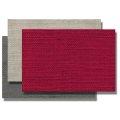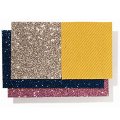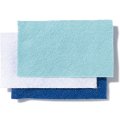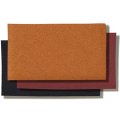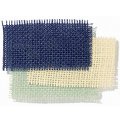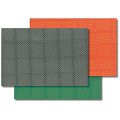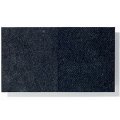Leather & faux leather
Information about leather and imitation leather
Besides wood, stone and wool, leather is one of the oldest materials humans have ever used. Thanks to its versatile properties, leather is still used today in many areas of everyday life. In addition to the automotive industry, which uses leather for seat covers and interiors, it is mainly used in bags, clothing, shoes and furniture. Leather is extremely durable and tough. When processed properly, it is both supple and soft. It is breathable and has a good insulating effect against cold and heat.
Production of leather
Leather is produced by tanning the raw animal skin. This is "chemically and mechanically processed so that it obtains new properties such as resistance to rot, permanent softness and temperature resistance" (according to G. Moog). Tanning agents react with the protein molecules (collagens) of the animal skin and thus prevent its decay in the long term.
Vegetable tanning uses vegetable substances with a high tannin content (e.g. gall apples, chestnuts, oak, beech and fir bark). Whereas traditional plant tanning used to take several months or even years, today the tanning process is accelerated and lasts only a few days.
Mineral tanning, which replaced vegetable tanning in the middle of the 20th century, mainly uses chromium(III) salts extracted from chrome iron stone. Because the process takes only a few hours, about 85% of the leather is chrome tanned today.
Each leather has two sides: the smooth grain side and the rough flesh side. The grain side is the side from which the hair grew; therefore pores can be seen here. The grain side is processed into smooth leather, nappa leather or nubuck leather in various processes. The natural, species-typical scar pattern is retained. The leather is often split into several layers. Rough and suede leather or split leather are produced from the split layers. To produce split leather, the split side is "prepared" by applying skin-thin layers of paint.
Production and properties of leather fibre fabric
Since 1917, leather fibre fabric, also known as "Lefa", has been produced from leather residues from the leather industry, natural latex (binding agent), natural fats and tanning agents - more than 95% of it therefore consists of natural raw materials.
Lefa's manufacturing process is similar to that of paper production: a fibre pulp made from crushed leather residues and the additives natural latex, fats and tanning agents is placed on an endless drainage screen, drained in a vacuum, dried in a drying tunnel and wound onto rolls or cut into sheets.
Lefa has leather-like properties: it is flexible but firm and can be processed like leather: You can sew, rivet, glue, punch, emboss... Manual processing makes it easy to cut with a cutter.
Most of Lefa's production goes to the shoe industry, where it is processed, for example, into rear caps, heels and soles. In recent years, however, the technology of Lefa production has undergone significant further development. Today the manufacturers refine the surfaces of the recycled leather in various forms for further applications.
In the meantime, very thin, surface-dyed or grained qualities are also available, which the bookbinder uses for exclusive book covers. In addition, leather fibre fabric is used by the furniture industry as upholstery fabric because, unlike genuine leather, homogeneous thicknesses, colours, sizes and surfaces are available. For the layman, the refined varieties in particular are indistinguishable from genuine leather at first glance, especially as leather fibre fabric still smells strongly of leather.
Leather processing
Cutting: The leather cords (round, flat) can be cut with fabric or household scissors. A cutting knife (cutter, scalpel or rollcutter), an iron ruler and a cutting mat are required to cut the full and split leather straps. Contact adhesives (e.g. Pattex Classic Kraftkleber) can be used for gluing large areas, superglue for smaller areas (e.g. Weicon Sekundenkleber VA 1500, thick). Uhu textile can also be used to bond leather with other textiles.
Punching: The Lever Revolver Hole Punch Pliers 370 are useful for making holes from 2 to 4.5 millimetres in diameter. Larger holes can be punched with a punch. Smaller holes are punched with an awl. When using eyelets / rivets set packs, e.g. from the company Prym, it should be noted that an additional punch pliers or a punch iron is required, as the hand punch / punch tool supplied with the pack is not suitable for stronger materials. The hand punch / hole tool and a hammer or the Vario push-button, hole, rivet and eye pliers can be used for assembly. Suitable eyelets / rivets for the full and split leather straps are for example:
- Eyelet with pulley, nickel-plated brass with Ø 8 mm, 11 mm and 14 mm,
- Eye Steel, brass-coloured with l = 4.2 and l = 5.5 or
- Fixing rivets brass, two-tone.
Sewing: Waxed leather thread or strong saddler thread made of hemp or linen is used for hand sewing. To simplify hand sewing, prick the holes with an awl or pliers. To connect two leather parts, for example when attaching a belt buckle, fastening rivets can be used or the pre-punched leather parts can be connected with a book screw.
Printing and dyeing: Pigmented stamping ink (e.g. Pelikan stamping ink 84 or StazOn stamping pad For every Surface) is suitable for printing on leather straps. Daler-Rowney gilding paste Goldfinger, for example, can be used to colour the velour cord or to paint roughened leather surfaces.
